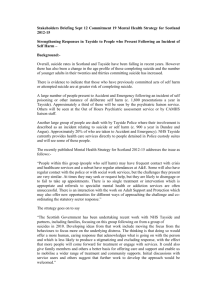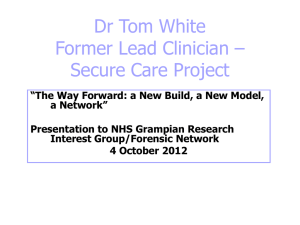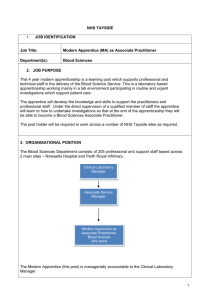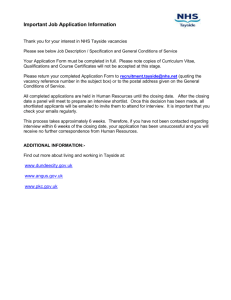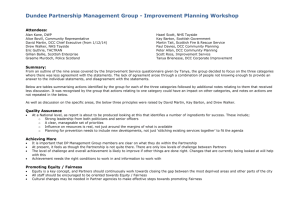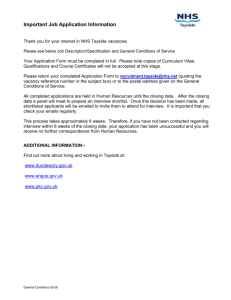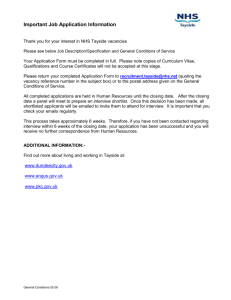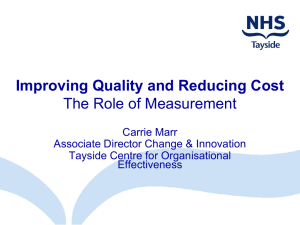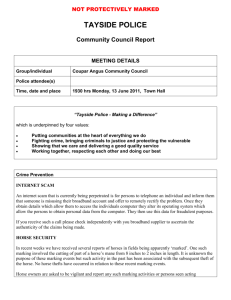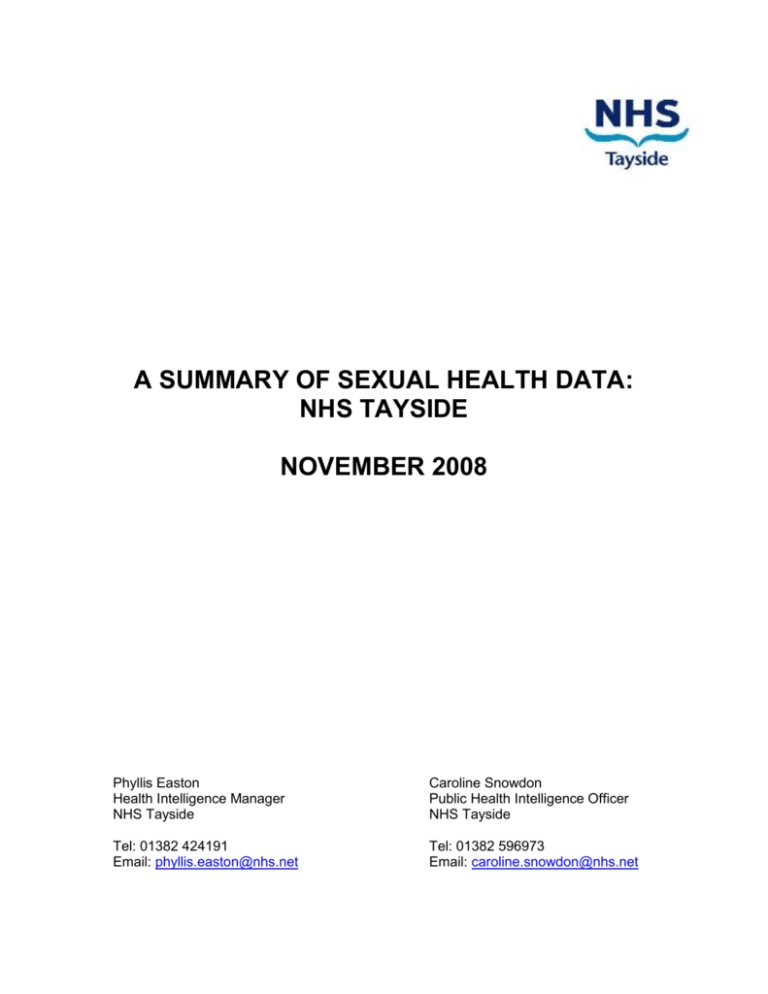
A SUMMARY OF SEXUAL HEALTH DATA:
NHS TAYSIDE
NOVEMBER 2008
Phyllis Easton
Health Intelligence Manager
NHS Tayside
Caroline Snowdon
Public Health Intelligence Officer
NHS Tayside
Tel: 01382 424191
Email: phyllis.easton@nhs.net
Tel: 01382 596973
Email: caroline.snowdon@nhs.net
Introduction
This document sets out the data in relation to the sexual health issues and challenges
for NHS Tayside. Currently, the clinical data relies on manual processing but the
development of the new NHS Scotland National Sexual Health System (NaSH) will
provide more robust and accessible electronic data. For each topic, the latest available
data is presented here.
Sexual activity in young people
While it is difficult to estimate the levels of sexual activity in young people, particularly
those under 16, the following points highlight issues of concern with this age group.
A recent conference reported that around one-third of Scots are sexually active
when they are under 16 years old.1
Research from the East of Scotland, including Tayside, has reported that, at first
sexual intercourse, the age of young people and their partners and non-use of
contraception are most strongly associated with pregnancy.2
The uptake of pregnancy testing and emergency contraception in young people
across Tayside suggests high rates of unprotected sexual activity, with associated health
risks.
The incidence of sexually transmitted infections, particularly in young women is
rising.
Many more young people may be suffering from infections which show no
symptoms. The effects of untreated Chlamydia can include pelvic inflammatory disease
and subsequent infertility, potentially serious outcomes from an infection which is easily
treated if diagnosed early.
In research carried out with young people under 15 in Scotland, 45% of girls and
32% of boys who had had sexual intercourse expressed regret, the majority stating that
it had happened too early and a proportion (13% of girls, 5% of boys) stating that it
should not have happened at all. 60% of respondents who had experienced intercourse
reported using a condom, which meant that 40% did not.3
Teenage conception
NHS Tayside has shown consistently higher conception rates in the under 16 age group
than Scotland. The chart below illustrates this over time. The Tayside trend decreased
between 1999 and 2004 and has shown a slight rise since then.
2
Conceptions in women age <16
Rate per 1000
14.0
12.0
10.0
8.0
6.0
4.0
2.0
1998
1999
2000
2001
2002
2003
Scotland
2004
2005
2006 p 2007e
Tayside
Source: ISD Online
p 2006 data are provisional
e 2007 point is an estimate from data for the first three quarters of the year
Includes pregnancies in women aged 13 to 15 years old (at the time of conception) ending in a live or stillbirth and pregnancies resulting in
a therapeutic abortion or miscarriage which required hospital inpatient or day-case treatment. Excludes home births and births at nonNHS hospitals.
The table below shows the pregnancy rates in those aged under 16 for three year
periods from 1998 to 2006. When individual areas are considered, there are vast
differences. Dundee City has by far the highest rate in Scotland and has been
consistently much higher than the other two areas in Tayside.
Rates of pregnancies per 1,000 females aged <16 years
Area of
Residence
Scotland
Tayside NHS
Board
Angus
Dundee City
Perth & Kinross
1998/00 1999/01 2000/02 2001/03 2002/04 2003/05 2004/06p
7.6
7.1
7.1
7.0
7.3
7.2
7.6
12.2
9.4
16.5
5.8
11.6
9.6
13.9
5.5
10.6
9.1
11.1
6.1
11.6
8.5
11.3
5.9
13.2
6.2
12.0
5.8
12.0
4.9
14.2
5.3
10.5
5.3
15.3
5.3
Source: ISD Online.
P 2004/06 data are provisional
3
Although pregnancy rates are high, particularly in Dundee City, the actual numbers of
pregnancies are fairly small as shown in the table below. Again, due to small numbers
and issues of confidentiality, the data are presented in three year totals according to
national practice.
Numbers of pregnancies per 1,000 females aged <16 years
Area of Residence
Angus
Dundee City
Perth & Kinross
1998/00 1999/01 2000/02 2001/03 2002/04 2003/05 2004/06p
58
59
55
51
37
29
32
131
112
88
87
90
106
115
46
44
49
46
44
40
41
Source: ISD Online
P 2004/06 data are provisional
The next chart compares the under 16 conception rates for the three local authority
areas in NHS Tayside with Scotland. A considerable decrease in the rate for Dundee
City was shown in 2001 but an increasing trend is shown since then. Over time, Perth
and Kinross has been just below the Scottish average rate, while the Angus rate has
decreased from one that was above the Scottish average to one similar to Perth and
Kinross.
Conceptions per 1000 females aged
13-15yrs
Rate of teenage conceptions per 1000 females age <16 years
18
16
14
12
10
8
6
4
2
0
1998/00
1999/01
2000/02
2001/03
2002/04
2003/05
2004/06p
Year
Scotland
Tayside NHS Board
Angus
Dundee City
Perth & Kinross
Source: ISD Online
Includes pregnancies in women aged 13 to 15 years old (at the time of conception) ending in a live or stillbirth
and pregnancies resulting in a therapeutic abortion or miscarriage which required hospital inpatient or day-case treatment.
Excludes home births and births at non-NHS hospitals.
4
Teenage conception and deprivation
There is an association between deprivation and the teenage conception rate. The chart
below shows pregnancy rates by deprivation quintile of the Scottish Index of Multiple
Deprivation (SIMD). In the most affluent quintiles, 1 and 2, numbers of pregnancies in
Tayside are very small and are suppressed in the published data. As deprivation
increases to the most deprived quintile, 5, so do pregnancy rates in this age group. The
chart below shows similar patterns for both Tayside and for Scotland, with Tayside rates
being higher for SIMD quintiles 3 to 5.
Pregnancy rate per 1000: age 13-15 by deprivation: Tayside 2005
50
40
30
10
22
20.5
20
3
8.8
6.1
4.1
13
9.2
0
1
2
3
4
5
SIMD quintile (1=most affluent)
Scotland
Tayside
Source: ISD Online
As well as demonstrating lower pregnancy rates, those in the most affluent areas as
measured by SIMD show different outcomes when a conception does occur. A much
higher rate of young women in more affluent areas terminate their pregnancy.
5
Pregnancy outcome (%) by deprivation quintile age 13-15: Scotland 2005
140
120
100
79
80
72
64
60
49
40
51
50
50
36
21
28
20
0
1
2
3
4
5
SIMD quintile (1=most affluent)
Delivered
Aborted
Source: ISD Online
Abortions
Abortion rates in women aged 15-44 have been consistently higher in Tayside than in
Scotland over the last 10 years, shown in the next chart.
Abortion rates per 1000 women aged 15-44
Rate per 1000 women age 15-44
20
16.8
16
12
15.6
14.4
11.5
11.1
15.7
15.2
14
11.2
17.1
16.4
15.4
14
11.1
10.8
11.6
12.0
11.8
12.5
13.0
8
4
0
1998
1999
2000
2001
2002
Tayside
2003
2004
2005
2006
2007 p
Scotland
Source: ISD Online
Notes: Refers to therapeutic abortions notified in accordance with the Abortion Act 1967
6
Abortion rates vary within Tayside, with Dundee City showing the highest rates over
time. The chart below shows abortion rates in each area for the years 2003 to 2007.
Rate per 1000 women aged 15-44
Abortion rates per 1000 women aged 15-44
by local authority area
25.0
19.8
18.6
20.0
15.8
15.0
14.1 14.7
19.0 21.1
18.7
14.9
14.9
13.9
13.2
14.0
13.6
11.7
10.0
5.0
0.0
Angus
Dundee City
2003
2004
2005r
Perth & Kinross
2006r
2007p
Source: ISD Online
Notes: 2007 figures are provisional
Refers to therapeutic abortions notified in accordance with the Abortion Act 1967
The chart below shows that, in those under 16, conception is considerably more likely to
end in a termination and in recent years, over two thirds of pregnancies in this age group
have been aborted.
No. deliveries or terminations
Outcome of pregnancy in under 16 age group: Tayside
60
40
46
38
46
40
47
41
40
38
34
24
24
32
29
20
47
19
19
20
2003
2004
2005
23
0
1998
1999
2000
2001
2002
2006
Year
Delivered
Aborted
Source: ISD Online
7
Among all teenage women (aged less than 20), the proportion of conceptions ending in
termination has risen over time as the table below demonstrates.
Pregnancy outcomes in Tayside women aged <20 years
Total
Year
Delivered Aborted pregnancies
1998
488
311
799
1999
486
317
803
2000
487
313
800
2001
446
305
751
2002
416
310
726
2003
470
371
841
2004
473
340
813
2005
484
374
858
2006
456
373
829
Percentage
aborted
38.9
39.4
39.1
40.6
42.6
44.1
41.8
43.6
45.0
Source: GRO online
Repeat abortions
Figures for 2006 and 2007 show that of all abortions, 30.1% and 29.6% respectively, are
to women who have had one or more previous abortions.
Sexual and Reproductive Health Services
The numbers accessing family planning services have been rising over recent years as
the chart below shows.
Number of family planning clinic attendances: New and Return
Num be r o f at t e ndance s
25000
20000
15000
10000
5000
0
2004
2005
2006
2007
2008
Ye ar
Note: 2008 figure is based upon the first two quarters of 2008; Source: Tayside Family Planning
Service data
8
Emergency hormonal contraception
The uptake of emergency hormonal contraception (EHC) is shown below.
To t al di spe nse d
Uptake of Emergency Hormonal Contraception
1800
1600
1400
1200
1000
800
600
400
200
0
2006 2006 2006 2006 2007 2007 2007 2007 2008 2008 2008 2008
Qtr 1
Qtr 2
Qtr 3
Qtr 4
Qtr 1
Qtr 2
Qtr 3
Qtr 4
Qtr 1
Qtr 2
Qtr 3
Qtr 4
Ye ar
Note: 2008 figures are based on January - June 2008
Source: Ascribe and Prisms
Long acting reversible contraception
The next chart shows the uptake of long acting reversible contraception (LARC)
Uptake of Long Acting Reversible Contraception
Total dispensed
20000
15000
10000
5000
0
2005
2006
2007
2008
Year
Note: 2008 figures are based on January - June 2008
Source: Ascribe and Prisms
9
Sexually Transmitted Infections
In Tayside, rates of Chlamydia and other sexually transmitted infections (STIs) are
increasing. The highest rates are found in the age 16-25 group in both genders. The
increasing rates can be partly explained by the increase in clinical activity and higher
rates of case finding.
Uptake of Genitourinary Medicine Services
The uptake of clinical services within Genitourinary Medicine (GUM) is increasing over
time as shown in the chart below. Recording has changed over the period and current
figures show number of cases while previous data has counted consultations with
different professionals at the same visit as separate contacts. The increase in
attendance is therefore greater than the chart suggests.
Attendances at NHS Tayside Sexual Health Clinics
Num be r o f at t e ndance s
12000
10000
8000
6000
4000
2000
0
2005
2006
2007
2008
Ye ar
2005 - 2007 figures from PRI are estimates based on quarterly averages for each year
2008 figure is based on Ninewells and PRI January - August 2008 data
Source: Tayside Clinic data
Chlamydia testing
The chart below shows the number of Chlamydia tests performed in Tayside and that
numbers are much higher in women than in men.
10
Num be r o f t e st s
Number of Chlamydia tests performed: Tayside
8000
7000
6000
5000
4000
3000
2000
1000
0
2005 2006 2007
Ye ar
Men 15 to 24 years
Men 25 to 49 years
Women 15 to 24 years
Women 25 to 49 years
Source: Population based Key Clinical Indicators for Sexual Health 2005 - 2007
Positivity rates vary across gender and age groups and are highest among young men,
mainly because those accessing services are a higher risk group and are, for example,
more likely to attend after contact tracing. Positivity rates are fairly low in women aged
25 and over.
25
20
t e st s
P e r ce nt ag e o f po si t i ve
Proportion of Chlamydia tests which are positive: Tayside
15
10
5
0
2005 2006 2007
Ye ar
Men 15 to 24 years
Men 25 to 49 years
Women 15 to 24 years
Women 25 to 49 years
Source: Health Protection Scotland - HIV reports database (as at 31st March 2007)
11
HIV
Numbers of HIV reports per year are small but, as shown in the chart below, the number
of cases occurring through heterosexual contact is showing an upward trend.
Number of reports
30
25
20
15
10
5
0
1995 1996 1997 1998 1999 2000 2001 2002 2003 2004 2005 2006
Year
Sexual intercourse between men
Sexual intercourse between men and women
Injecting Drug Users
NHS Tayside
Source: Health Protection Scotland - HIV reports database (as at 31st March 2007)
Overall, HIV reports in Scotland are increasing and while there were 171 reports in 2001,
the number in 2006 was the highest recorded for a single year at 453.
There is considerable variation in the incidence of HIV between the different Community
Planning areas in Tayside. The number of people with HIV is much higher in Dundee
City, and accounts for 68% of the current HIV population (where the Local Authority area
is recorded).
Access to services
Lesbian, Gay, Bisexual Or Transgender Population
National research has highlighted issues for people who are lesbian, gay, bisexual or
transgender, mainly in terms of barriers to accessing sexual health services. Work
carried out locally in a survey with 95 respondents confirmed that, although many
reported positive experiences with healthcare services, 13% had experienced difficulties.
Of particular importance were issues in relation to cervical smear testing and
assumptions about heterosexual relationships when asking for any advice related to
sexual health.
12
Ethnic minorities
The non-white ethnic population in Tayside forms 1.9% of the total population. Cultural
beliefs in relation to sexual behaviour and sexual health may be in conflict with the
prevailing social norms and this needs to be acknowledged in addressing the sexual
health needs of this population.
Conclusion
This document has presented data in relation to the main issues and challenges for NHS
Tayside. In young people in particular, pregnancy and sexually transmitted infection
rates are measured against an increasing sexually active population. The rising trends
in accessing clinical services can show an increase in some indicators, such as higher
rates of sexually transmitted infections due to case finding. The available data is
regularly updated and monitored across the range of indicators presented here.
References
1. Does the law matter? Young people, sex and relationships. Report of conference
held by Children 1st and Childline, Edinburgh 17th June 2008.
2. Buston K, Williamson L, Hart G. Young women under 16 years with experience of
sexual intercourse: who becomes pregnant? J Epidemiol Community Health 2007; 61:
221-225.
3. Wight D, Henderson M, Raab G, Abraham C, Buston K, Scott S, Hart G.
Extent of regretted sexual intercourse among young teenagers in Scotland: a cross
sectional survey. BMJ 2000; 320: 1243 – 1244.
13


